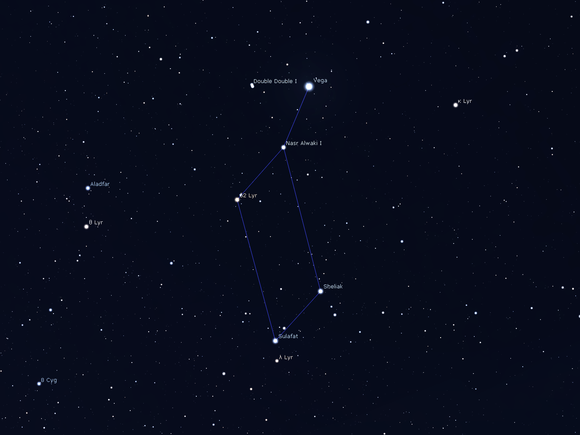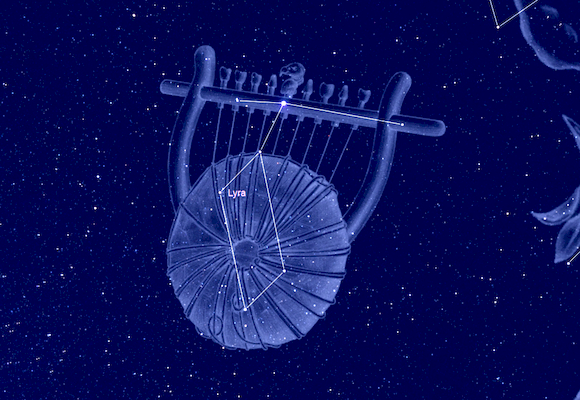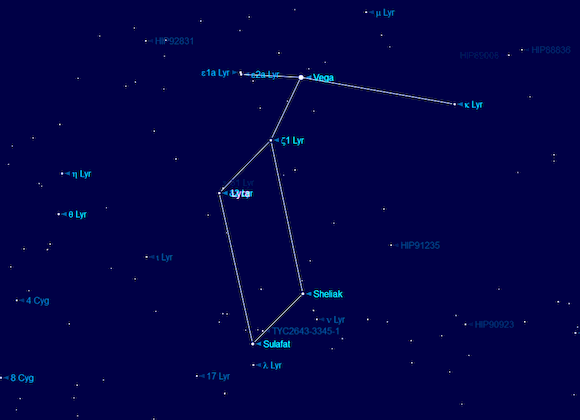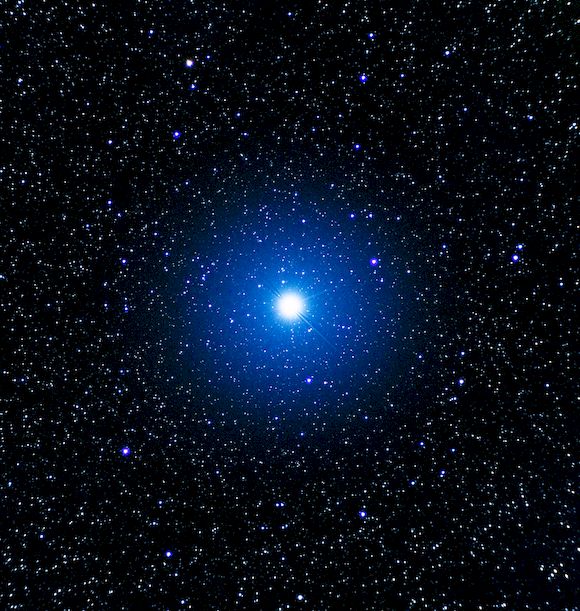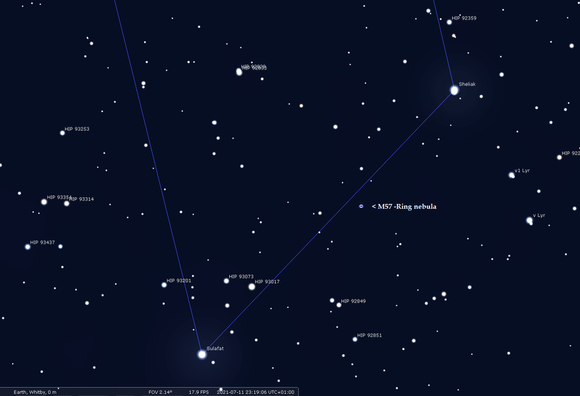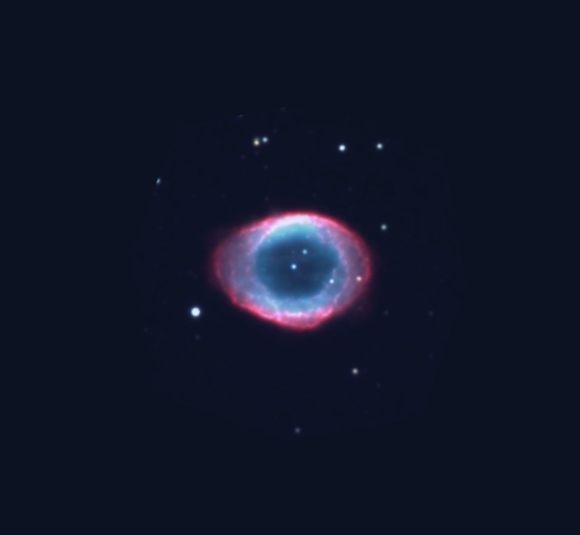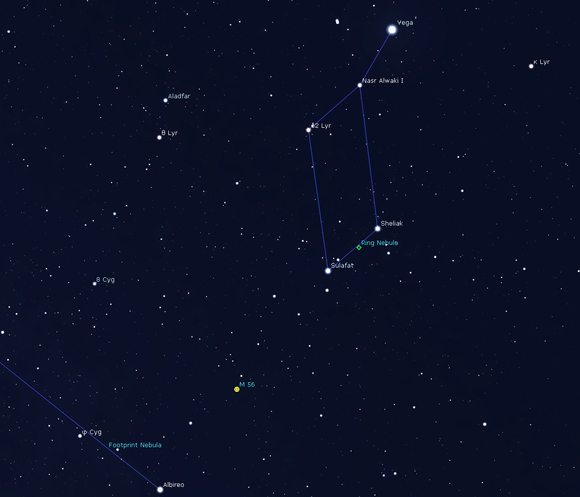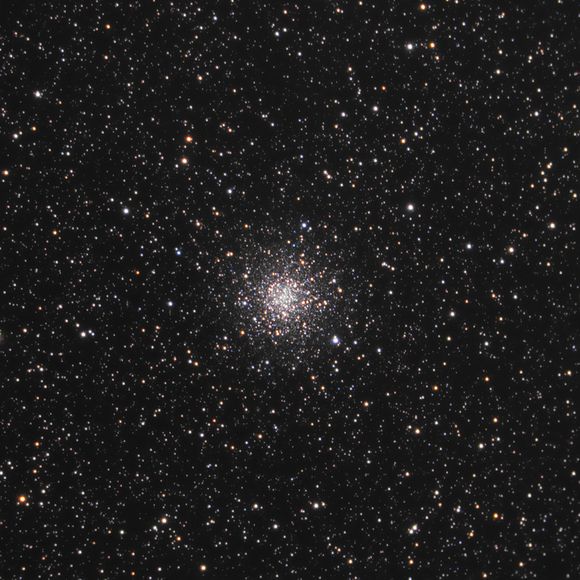Lyra is one of the original 48 constellations listed by the 2nd century astronomer Ptolemy in the Almagest and one of the most distinctive, having a geometric outline. It is quite small, ranking 52nd in size out of the 88 listed today. It is bordered by Draco, Hercules, Vulpecula, and Cygnus and from UK latitudes is circumpolar, (just about). The constellation contains several of objects of note, including the bright star Vega, the planetary nebula - M57 and the double-double star. Lyra is one of the 'summer triangle constellations'.
In Greek mythology, Lyra represents the lyre of Orpheus, said to be the first made by Hermes from a stringed tortoise shell, before being given to Apollo. Orpheus was the son of the Thracian King Oeagrus and the muse Calliope. When he was young, Apollo taught him to play his harp, giving the instrument to him, whilst Orpheus's mother taught him to write verses. Orpheus's music was said to be so great that even inanimate objects such as trees, streams, and rocks could be charmed. Joining Jason and the Argonauts, his music was able to quell the voices of the dangerous Sirens, who sang tempting songs to the Argonauts.
The most famous story involving Orpheus relates to his attempts to save his wife Eurydice. She was fleeing an attack from a satyr, but fell into a nest of vipers, was bitten and died. The gods felt pity for Orpheus and advised him to travel to the underworld and try to retrieve Eurydice. Once there, his song deeply moved Hades and his wife Persephone and they agreed to return Eurydice to the world of the living on one condition: that he never once look back until outside. Unfortunately, Orpheus forgot that they both had to arrive to the upper world before he could turn, and before Eurydice reached safety, he faltered and looked back, causing Eurydice to fade back into the Underworld forever. A distraught Orpheus wandered the countryside plaintively playing his lyra and rejecting the advances of many women, preferring the company of young boys. Offended by his rejections they ganged up on Orpheus, stoning and spearing him to death. According to Eratosthenes, however Orpheus failed to make a necessary sacrifice to Dionysus due to his regard for Apollo as the supreme deity instead. Dionysus then sent his followers to rip Orpheus apart. In both myths his lyre was placed in the sky by Zeus.
Orpheus, Eurydice, Hades and Persephone,
By Rubens, 1636-38. Museo Nacional del Prado (click for larger image)
In a popular Chinese folk tale, one of the few star legends to have passed down from ancient China, Vega is said to represent the weaving girl, granddaughter of the celestial emperor. She made beautiful silks for the gods and goddesses, but she fell in love with a lowly cowherd, represented by the star Altair in Aquila. Following their marriage the couple began to neglect their duties, so to prevent further interruption to their work the emperor separated them, placing them on opposite sides of the Milky Way. The Cowherd was left to bring up their two sons, represented by the stars either side of Altair. Thereafter, the couple were allowed to meet only once a year, on the 7th night of the 7th moon, when magpies bridged the Milky Way with their wings.
One of the jewels of the summer night sky is undoubtedly Vega. From mid/high northern latitudes, including the UK, Vega is visible all year round (circumpolar) and always attracts attention. Although not quite the brightest star visible during summer month's; that accolade goes to Arcturus, it is usually first to emerge in the twilight sky.
- Alpha Lyrae - Vega, a name which is derived from the Arabic for ‘The Swooping Eagle’ and was often depicted as the eagle bearing the harp in its beak or talons. With an apparent magnitude of 0.03, Vega is the 2nd brightest star visible from the northern hemisphere and 5th brightest star overall. The star belongs to the spectral class A0V and is 2.1 times the Suns mass and 58 times more luminous. Until very recently it was believed to be less than 450 million years old, about a tenth of the Suns age, but for Vega this already equates half its life expectancy. However, new estimates indicate that Vega is significantly older than previously thought. Scientists, who will shortly publish their findings in The Astrophysical Journal Letters, suggest that Vega spins faster than thought, about once every 12 hours or so. This stirs up the star’s interior, and forces the surface composition to match the overall composition of the star, causing an overestimation of Vega’s abundance of heavy metals. This in turn led to an overestimation of the stars mass and an underestimation of its age. Astronomers studied Vega using the CHARA interferometer, an array of telescopes in California, modelling observations by using new computations of how fast-spinning stars age. Astronomers who studied Vega now believe it is between 625 million and 850 million years old, old enough for planets to have formed and sufficient time for the development of primitive life.Vega is 2.8 million miles in diameter and is surrounded by a circumstellar debris disk, similar to the Kuiper Belt around our Sun and may possibly contain at least one Jupiter sized planet. Vega was the first star other than the Sun to be photographed in July of 1850, and the first one to have its spectrum recorded.
- Sheliak or Beta lyrae, signifying the tortoise, is the leading example of the Lyrid or bright eclipsing variable star. Its magnitude continually varies sinusoidal manner between +3.8 and 4.1 due to mutual eclipses of two unequally bright stars in a period of almost 13 days. It is one of the most studied stars in the sky due to changes in its spectrum. The primary is a brilliant B8 type star some almost 20 times the Suns diameter and over 3000 times brighter. The secondary is an A7 type star 15 times the diameter of the Sun. They are separated by just 22 million miles, close enough for their atmospheres to intermingle – giving rise to the unusual spectrum. Indeed there appears to be a stream of gases along which matter streams from one star to the other reducing the separation between them. It is thought that when the masses of the two star become more equal this will stop, and reverse mass flow will occur, widening the gap again. All most complicated:, and some 900 light years distant.
- Sulafat – (Gamma Lyrae – the turtle) is the second brightest star in the constellation with an apparent magnitude of 3.2 and is approximately 620 light years distant from the Sun. The star is a blue-white giant of spectral class B9 III. The star has a radius 15 times that of the Sun. Lying close to Beta in the constellation it is a good comparison star for brightness.
- Delta Lyrae consists of a star and a star system separated by 10.5 arc minutes – forming a wide binocular pairing with noticeable colour contrast. Delta-1 Lyrae is a binary star system with an orbital period of about 88 days. The components have apparent magnitudes of 5.569 and 9.8. The primary star is a blue-white dwarf with the stellar classification of B2.5 V. The companion is an orange giant of the spectral type K2III, which makes it brighter and larger, yet cooler than the Sun. The separation between the two stars is very small and they form a spectroscopic binary. The system is approximately 1,100 light years distant from the Sun. Delta-2 Lyrae is a red bright giant with the stellar classification M4 II. It has an apparent magnitude of 4.30 and is approximately 740 light years distant. It is 6,500 times more luminous than the Sun and has a radius 200 times solar. The star is believed to be 75 million years old.
- Epsilon Lyra -the double-double, as it is popularly known, is one of the most famous examples a multiple star system in the sky. It is easily located 1 ½ degrees north east of Vega and with an apparent magnitude of +4.7 it appears as a single star to the average naked eye. In binoculars the system appears as two stars, each of which can be resolved into a binary when observed through a telescope. The two main components, the binary stars, orbit each other. Epsilon-1 Lyrae, the northern component in the system, is a double star consisting of components that are only 2.35 arc seconds apart. The stars have apparent magnitudes of 4.7 and 6.2 and an orbital period of about 1,200 years. The true separation of the two stars is around 155 AU. The stars of Epsilon-2 Lyrae are separated by 2.3 arc seconds and have magnitudes of 5.1 and 5.5. Their orbital period is about half that of the Epsilon-1 stars. The true separation is approximately 165 AU. When viewed with optical aid there appears very little colour contrast between any of stars which appear white, although Epsilon 1 perhaps tends to be a little blue-white in hue. The two wider components are 13,000 AU apart, roughly a fifth of a light year. Epsilon Lyrae has a fifth component, discovered in 1985. The star orbits the Epsilon-2 pair with an estimated period of a few decades. The whole system lies around 163 light years distant.
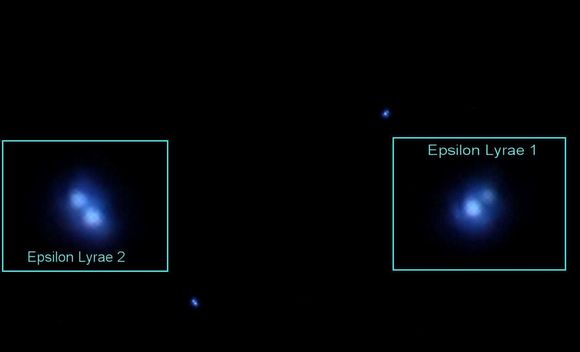
Star: Epsilon Lyrae, the double-double
(Image: Jenham's Astro YouTube video where you can see image captured)
- Kappa Lyrae is an orange giant star of spectral stellar classification K2III. It has an apparent magnitude of 4.323 and is approximately 238 light years distant from us. It is classified as a variable star.
- Alathfar – Mu Lyrae - ‘the talons’ (of the swooping eagle) lies 2.5 degrees west-northwest of Vega and is a white sub giant star belonging to the spectral class A3IVn. It has an apparent magnitude of 5.12 and is approximately 439 light years distant from Earth.
- Gliese 758 is a yellow dwarf with the stellar classification of G8V. It has an apparent magnitude of 6.36 and is 51.4 light years distant from the Sun. It can easily be seen in binoculars. The star is similar to the Sun, having 97 percent the Sun’s mass, and 51 percent higher metallicity, i.e. abundance of elements other than hydrogen and helium. A sub stellar companion, Gliese 758 b, was discovered in the star’s orbit in November 2009. It has between 30 and 40 Jupiter masses.
- RR Lyrae is the brightest known example of a large number of pulsating variable stars similar in nature to Cepheid’s but with lower luminosities and shorter periods; typically less than 1 day. This type of variable star is found in great abundance in many globular clusters, but not exclusively so. None are naked eye objects; RR Lyrae has a magnitude variation of 7.1 to 8 over a period of 0.56 days. Its spectral class changes from A to F over the course of the light cycle. The luminosity of RR variables is between 50-65 times that of the Sun, this uniformity making them good distance indicators. RR Lyrae itself is around 900 light years distant.
Deep sky Objects
Lyra contains two Messier objects; M56 and M57.
M57 (NGC 6720) – the Ring Nebula, perhaps the best known Planetary nebula, was discovered in early January 1779, being only the second one to be found. The discoverer; Antione de Darquier de Pellopiox, wrote “as large as Jupiter, looks like a fading planet” and so the name Planetary Nebula was coined. Messier; having learned of the discovery, observed it himself later that month. William Herschel thought it looked like a faint ring of stars around a void, “one of the curiosities of the heavens”.
The Ring nebula is 2300 light years distant making the ring approximately 0.9 light years in size, although the outer halo extends to 2.5 light years. The central ellipsoidal part of the nebula, which appears to us as the ring is expanding at 50km /s, being pushed out by the hot winds emanating from the central star and clashing with slowly expanding halo gas. This left the central star just 20,000 years ago when it was still a red giant. This probably makes the Ring Nebula around 10,000 years old. The exposed hot core of the former red giant star has an approximate solar luminosity of one with a temperature of 100,000K.
M57 can be spotted with larger sized binoculars, but only as a faint star. A magnification of 100x will reveal the ‘smoke ring’ of the nebula. Apertures of 125mm plus will start to show the oval form of M57. Apertures exceeding 12” are required to glimpse the central star itself. The globular cluster M56 or NGC 6779 was discovered by Charles Messier in March of 1779 midway between Albireo (Beta Cygni) and Sulafat (Gamma Lyrae). In a good sized binoculars (50–80 mm) range it appears as a slightly fuzzy star. The cluster can be resolved using a telescope with an aperture of 6 in (150cm) or larger. M56 lies around 32,900 light-years away from Earth and measures roughly 84 light-years across, containing 220,000 solar masses. The cluster has an estimated age of 13.70 billion years and is following a retrograde orbit through the Milky Way. The properties of this cluster suggest that it may have been acquired during the merger of a dwarf galaxy, of which Omega Centauri forms the surviving nucleus. The brightest stars in M56 are of 13th magnitude, while it contains only about a dozen known variable stars.
- Credits - Sky Charts: Stellarium Software and Starry Night Pro Plus 8 unless otherwise stated.
- Log in to post comments

